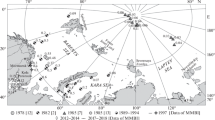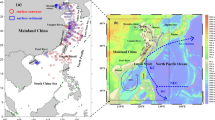Abstract
The Baltic Sea is ecologically unique as one of the world’s largest brackish water basins. It was significantly contaminated by radioactivity following the Chernobyl accident in 1986, the major contaminant being long-lived 137Cs. Due to the slow exchange of water between the Baltic Sea and the North Sea and the relatively rapid sedimentation rates, radionuclides have prolonged residence times in the Baltic Sea. 137Cs levels are consequently still clearly higher than in other water bodies around the world. In addition to the Chernobyl accident, artificial radionuclides in the Baltic Sea originate from the global fallout following nuclear weapons testing in the 1950s and 1960s, while discharges into the Baltic Sea from nuclear power plants and other facilities are of minor importance. Here, inventories and the temporal evolution of radionuclides both in seawater and sediments of the Baltic Sea are presented and discussed.





Similar content being viewed by others
References
Leppäranta M, Myberg K (2009) Physical oceanography of the Baltic Sea. Springer, Berlin, Heidelberg, New York
Voipio A (ed) (1981) The Baltic Sea. Elsevier oceanography series 30. Elsevier, Amsterdam
Helcom (2009) Baltic Sea Environ Proc 117:9–54
Mattila J, Kankaanpää H, Ilus E (2006) Boreal Environ Res 11:95
Zalewska T, Lipska J (2006) J Environ Radioact 91:1
Styro D, Morkuniene R, Vdovinskiene S (2006) Oceanology 46(3):358
Davuliene L, Tarasiuk N, Spirkauskaite N, Trinkunas G, Valkunas L (2007) Oceanologia 49(1):71
Aldahan A, Possnert G, Alfimov V, Cato I, Kekli A (2007) Nucl Instrum Methods Phys Res B 259:491
Ilus E (2007) Boreal Environ Res 12:1
Helcom (2003) Baltic Sea Environ Proc 85:5–23
Helcom (1995) Baltic Sea Environ Proc 61:30
Helcom (2007) Baltic Sea Environ Proc 110:1
Helcom (2000) Baltic Sea Environ Proc 80:1
Salo A, Tuomainen K, Voipio A (1986) Sci Total Environ 54:247
Helcom (1996) Baltic Sea Environ Proc 64B:10
Saxén R, Ilus E (2001) J Environ Radioact 54:275
Ilus E, Ilus T (2000) In: Nielsen SP (ed) The radiological exposure of the population of the European Community to radioactivity in the Baltic Sea, Marina-Balt Project. Radiation Protection 110. Luxembourg, p 9
Salo A, Voipio A (1981) Mar Pollut Bull 12:6–218
Acknowledgements
We are grateful to HELCOM-MORS laboratories for sharing their data with us and we would like to thank the following persons for fruitful co-operation: Sven Nielsen (Denmark); Eia Jakobson (Estonia); Jürgen Herrmann and Günther Kanisch (Germany); Visvaldis Graveris (Latvia); Beata Vilimaite-Silobritiene (Lithuania); Maria Suplinska and Tamara Zalewska (Poland); Yuri Panteleev, Andrey Stepanov and Victor Tishkov (Russia); and Maria Lüning (Sweden).
Author information
Authors and Affiliations
Corresponding author
Rights and permissions
About this article
Cite this article
Ikäheimonen, T.K., Outola, I., Vartti, VP. et al. Radioactivity in the Baltic Sea: inventories and temporal trends of 137Cs and 90Sr in water and sediments. J Radioanal Nucl Chem 282, 419–425 (2009). https://doi.org/10.1007/s10967-009-0144-1
Received:
Accepted:
Published:
Issue Date:
DOI: https://doi.org/10.1007/s10967-009-0144-1




